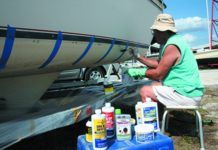Magellan GSC 100 vs. SASCO OceanMail 2000
I enjoyed the article in the December 1999 issue on the Magellan GCS 100; however I think you were overly critical of the unit. I bought one last February and used it every day on a passage in my Island Packet 32 from Honolulu to Victoria, Canada in June. It did exactly what I wanted it to do. It allowed me to keep in touch with my wife and friends during the passage at a reasonable cost. The GPS feature allows you to easily add your position with a few keystrokes so others can follow your progress.
The keyboard does take some getting used to and we did have a little frustration deciding when to switch from store and forward mode to standard, but overall it did the job. Yes, it did take time to send out messages but on a passage like that I had plenty of time and it only took me about a half hour each day to type a short message and locate a satellite for sending.
Cyrus M. Zittle
Scottsdale, Arizona
After two months experience with the GSC 100, I am thrilled with it. It is easy to use (pointing an antenna is no big deal), self-contained (no messing around with a computer), and 100% reliable. It is a tremendous kick to be quickly and easily in touch hundreds of miles out at sea.
Yes, the keyboard could be better, but this system is a technological marvel that will be deeply appreciated by all cruisers who want to stay in contact. If you don’t believe me, ask my mother!
Marc Horowitz
by GSC 100
Offshore on the Thorny Path
Re: the SASCO OceanMail 2000, Im having a problem with your arithmetic on page 29. 10,000 characters for $150 yields a per character charge of 1.5 not 15. Youre off by a factor of 10.
Stan Nackdymon
via e-mail
Youre right. Also, the phrase Includes 10 messages of up to 500 characters plus 30 message checks belonged under the Magellan GSC 100 column instead of OceanMail 2000.
E-mail
In the September 1999 issue, Dan Spurr presented the Readers Query of the Month: How can I get e-mail on my boat? He then went on to mention a possible $1,000 solution (The Magellan GSC 100 as well as the SASCO OceanMail 2000 [see letters in column to left], reviewed in December). Depending on what you really want, and where you sail, I know a cheaper way.
My wife and I sail the coastal waters of Florida, the Keys and the Bahamas during the winter months. Having hauled my laptop around for several years, trying to convince marinas or store owners to allow me to dial in, I was acutely aware of the difficulty. Then last winter, in Boca Grande, waiting to use the pay phone for a call to our family, we met some cruisers who had recently purchased a Sharp PocketMail. This little gadget, only 6″ long, contains an LCD screen in the lid, and a standard qwerty keyboard in the base. It is small and difficult to type on at first. But when you have typed your message, all you need do is, from any phone , dial an 800 number, hold the PocketMail up to the phone, and push a button.
It both sends and receives e-mail.
Furthermore, it contains an address book function, a daily schedule function, and a memo function. I even used it from Scotland in September (along with a phone card to get me into this country, where the 800 number takes over). And it works with a cell phone any place that a cell phone works. It is very fast. It costs only $150 at Office Depot, plus $100 a year for the server.
Directions about establishing an account are included with the package. You can arrange for your regular server to forward your e-mail to the PocketMail server, or you can give your PocketMail address to your friends before you go to the boat.
If you are mid-Atlantic, this is not for you. But if you are a coastal cruiser, this may be what you need.
Ed Barrett
Highlands, North Carolina
Tying Bungee Cord
A quick follow-up to your December 1999 PS Advisor on fastening bungee cord: I have had good success with a heavy, transparent shrink-tubing, sold by the foot at a local electronics surplus store. I bought the size to fit snugly over doubled 1/4″ bungee. It shrinks very tightly when warmed with a heat gun.
On my Contest 33 Ive had it on two shock cords, fastened to a small padeye, with stainless steel hooks on the free end that hold up a section of cockpit seats to create the T-shaped configuration I use most of the time.
Although I have a Bimini, the shrink wrap is exposed to several hours of morning and evening sun about six months a year. It has slightly yellowed after three seasons, but shows no sign of breaking down yet.
Peter Martyn
via e-mail
Chapmans references a knot specifically for shock cord. It is an old fishermans knot. I do not know how well it holds but it is easy to tie.
Make a loop with the end behind the standing part. Have the loop point to the right. Pull the end towards you under the standing part and then over the standing part, twice (basically a round turn). You then take the left-most loop (the first one made from passing the end over the standing part) and pass it through the original loop and pull on the standing part. This should make a knot that resembles a bowline with an X on the back.
Ron Smith
via e-mail
No Significan’t Features

Thanks for the review of No Significan’t Features (January 1, 1999). I thought you (and your readers) might like to know that you can now listen to audio clips and read reviews of No Significan’t Features online at cdbaby.com/buy/quinn.htm. It can also be ordered online at that address or by phone at 800/448-6369.
Eileen Quinn
via e-mail
Barnacle-free Prop
We sail our Hunter 30 in Toms River on Barnegat Bay, New Jersey. The water in our marina is brackish but that does not stop the barnacles. I have been struggling to keep my prop and shaft free of these crustaceans for several years. While the hull never has any of these hitchhikers, the prop and shaft are always completely covered when the boat is hauled after our four-to-five-month season.
I have tried several different approaches, including leaving the highly polished shaft and prop bare, coating them with wax, painting with bottom paint, and adding hot pepper to the paint. Nothing seemed to work. I don’t like the idea of removing my zincs and electrically isolating the shaft. This year I was successful.
Last spring, the shaft and prop were stripped of all old paint, buffed and polished clean and primed with two coats of Interlux 2000 barrier coat. I then applied one coat of Pettit Trinidad bottom paint. At the end of the season, there were no barnacles on the shaft and the Trinidad paint was intact. There were only a few barnacles on the concave surfaces of the prop blades, where some of the paint and primer had worn off.
John Tesoriero
Brielle, New Jersey
Black is Best
Nick Nicholson reports ultraviolet damage to the leech covering of a roller-reefing headsail (Offshore Log, June, 1999). Small wonder. White so-called UV shield Dacron is too often used on roller jibs, and was undoubtedly the leech tape that is coming apart near the beginning of his travels in the tropics. The sacrificial layer of Dacron he refers to will not be far behind. The coating (a white zinc compound) on this cloth extends its life about 20%. This sounds okay until you learn that tests show Dacron loses 40% of its strength after just THREE MONTHS in the Florida sun.
Experience points to Sunbrella in the darkest colors (ubiquitous blue is good, but black is best) for roller jib and mainsail covers. For jibs, the cost will be slightly higher than for UV-coated white Dacron, and the result a little heavier, but the alternative is what Nicholson calls a very expensive drop cloth.
Dark covers will last at least twice as long as white ones, and will protect the sails under them much more than twice as well. Black polyester thread will last longer than white, and should always be used on covers. Even so, in low latitudes jib and main covers will need restitching every three- to five-years. Eventually, even a dark cover will need replacing due to wear and tear, but the sail under it will often be nearly as good as new. Not so with a white cover. When it dies its early death, the sail under it is on its last legs. It is hard to convince customers that when it comes to protecting sails from UV, black is best and white is worst. Some instinct seems to suggest the reverse.
But isn’t white better because it reflects the sun?
Wont the heat generated by a dark cover harm the sail?
No, and no. The best practical test of the ability of a cover cloth to block UV is to hold up samples to the sun. If any light shows through, you can bet some UV is slipping through with it-visible and UV radiation are right next to each other in the spectrum.
In an earlier installment of Calypsos log, Nicholson reported finding green mold in the roller jibs. Even without the photo, we could have deduced the white covers. He will never find mildew in a dark covered sail as drying heat prevents its growth.
Stuart Hopkins
Dabbler Sails
Wicomico Church, Virginia
CycleFlush Correction
Regarding the CycleFlush marine toilet deodorizer described in the January 1, 2000 issue, please note that the device does not flush the toilet; rather it back flushes the intake line back out the seacock. Also, we have reduced its price to $119.95. Warranty is one year. And our area code has been changed.
Russell Tritico
Tritico Enterprises
714 Pujo St.
Lake Charles, LA 70601
337/436-6648




































